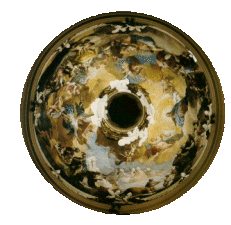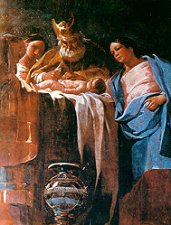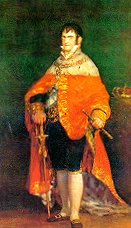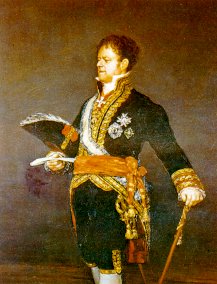GOYA IN ARAGON : Zaragoza and goya

Since his early youth, Francisco de Goya was linked to the Aragonese capital. The Goya family had a house in the centre of the city, in the old Morería street (nowadays Teniente Coronel Valenzuela st.), where his father had his gilding workshop.

In 1771, after his trip to Italy, Francisco de Goya installs his studio in the Nao arch, next to Coso st. and San Miguel square. Despite his moving to Madrid at the beginning of 1775, Goya does not lose his interest and follows closely the evolution of Aragonese life. The abundant correspondence with his childhood friend Martín Zapater, gives evidence of this. This businessman from Zaragoza will look after the painter's interests in the Aragonese capital, and at the same time, will keep him informed about the events.
Thanks to his links with the city of Zaragoza, he painted the Regina Martyrum dome in El Pilar, between 1780 and 1781. Afterwards, from October 1808, he spent several months in the city, collecting the images whose remembrances will originate a good number of the engravings of the series Los Desastres de la Guerra (The Disasters of War).
It is worth mentioning, for example, the engraving number 7, called ¡Qué valor! (What a courage!), where Agustina of Aragón is represented firing a cannon next to Portillo doorway. This is only one of the many engravings that testify about the hunger and miseries of the Aragonese people during the Independence War. Heart-rending visions of a city in ruins that, as the painter’s images and documents show, inflame his solidarity towards those people who shared his early years’ streets.
It is not strange that such a deep link to the land where he was born is reflected in the excellent examples of Goya's art conserved in the Aragonese capital.
Basilica of Our Lady of El Pilar. After his coming back from Italy in 1771, Francisco de Goya is asked to present a sketch for the dome of the coreto in El Pilar about The Adoration of the Name of God. The sketch will be approved in January 1772.
The composition follows the canons of the artistic period, with a strong influence from the Italian tradition. By means of clouds on different planes the sensation of depth is created, necessary to direct the spectator’s eyes towards the symbolic triangle. On the other hand, some of the fragments are executed in a sketch-like way, a prelude of his later and most characteristic works.
Years later, in 1780, Goya presents to the Chapter two semicircular sketches, together with those of his brothers-in-law, Francisco and Ramón Bayeu, to be carried out in the domes around the Saint Chapel, originating what we know as Regina Martyrum dome. Goya's sketches can be seen in the Basilica's Museum.
The Queen of Martyrs or Regina Martyrum was painted between 1780 and 1781. It is a fresco and it is considered to be one of Goya’s best works. The Virgin Mary is shown among clouds, surrounded by angels. Under her, the Holy Martyrs and the Aragonese clergymen gather and, on a second plane, the people’s martyrs, those of the army and childhood martyrs, represented by Santo Dominguito de Val.

In the four pendentives, equally interesting, Goya represents the four virtues: Strength, with a vigorous execution; Patience, in a quiet attitude; Charity, with naked children embracing her; and the beautiful figure of Faith in white tones.
The presence of the frescoes and sketches of Goya in the Basilica constitutes one of the important reasons that make Nuestra Señora del Pilar a compulsory stage for those who visit Zaragoza.
ADMISSION TIMES: From Tuesday to Sunday,
from 11 to 14. Every day: from 16 to 18.
ADDRESS: Pilar Square
Ibercaja owns two works by Francisco de Goya: the portrait of Félix de Azara, Aragonese naturalist and geographer (1805), and the half-length portrait of D. José Cistué y Coll, from around 1788. It is possible to see these works asking for a visit beforehand.
ADDRESS:
2, Paraíso Square.
Phone: +34 976223344
Being a private company, the visits should be arranged beforehand with the direction.
In the Throne Lounge of the Archbishopric Palace there is the oil portrait of Archbishop Joaquín Company (1800), a masterly example of the chromatic play of blacks and greys.
ADMISSION TIMES:
VISITORS ARE NOT ADMITTED.
The small oratory of the Palace of the Counts of Sobradiel or Gabarda (nowadays Notarial Association) was decorated by Goya after his trip to Italy, between 1771 and 1772. The paintings, badly preserved, were fragmented and went to different collections: The Dream of Saint Joseph to the Museum of Fine Arts of Zaragoza; The Descent to the Lázaro Galdiano Museum in Madrid; Santa Ana, San Joaquín, San Vicente Ferrer and San Cayetano, to foreign collections.
On the other hand, the wonderful paintings described by Jovellanos that were kept in San Fernando church, were destroyed or stolen during the Independence War. Only the sketches have been conserved: The Apparition of San Isidoro to San Fernando, which is now in Buenos Aires, and the other two, Santa Isabel and San Hermenegildo, in the Lázaro Galdiano Museum in Madrid.
Two other paintings are also missing: those of the altarpieces of the Parish church of Urrea de Gaén (Teruel): San Blas and Apparition of the Virgin of El Pilar, commissioned by the Duke of Hijar between 1782 and 1783.

Zaragoza, apart from the important legacy left by Goya, has a vast tourist offer that corresponds to its category as Aragonese capital with more than two thousand years of history. The visitor should not miss the opportunity to stroll along its streets and to know such interesting and emblematic monuments as La Seo cathedral, La Aljaferia Palace -current seat of Aragon Regional Assembly-; La Lonja Palace, the Roman walls and the Mudejar tower of La Magdalena, among others.
Carthusian Monastery of Aula Dei
CARTHUSIAN MONASTERY OF AULA DEI
11 km. from Zaragoza, on the road that goes along the left bank of the river Gallego from Santa Isabel quarter, on the way to Peñaflor and San Mateo de Gallego, we find the Carthusian Monastery of Aula Dei. In this important monastery, dating from the 16th to the 18th centuries, Francisco de Goya made a series of eleven oil mural paintings in 1774. Nowadays, seven works with a classicist tendency are conserved. The artist executed them with free and spontaneous strokes.
In the museum, the visitor has the opportunity to admire the series Los Caprichos (The Caprices), published in 1799. They are 80 satirical engravings where social critique adquires a grotesque tone unprecedented in his time.

The seven murals’ topics are centered around the Virgin Mary's life: San Joaquin and Santa Ana (the Virgin's parents); Mary's Nativity; Mary's Marriage; The Visit; The Circumcision; The Adoration of the Holy Kings; and The Purification of Mary or Presentation in the Temple. They are big works, with a monumental appearance that form an ensemble with a unique character in Goya's work.
The Carthusian order, whose members, or at least some of them, would become friends with the painter during the murals’ making, is still living in the monastery. We have to point out that, being an enclosed convent, entrance is only allowed to male visitors, due to the strict monastic rules.
ADMISSION TIMES:
Admission is only possible by a previous appointment.
Phone number: +34 976591366
Being an enclosed convent, women are not allowed to enter the monastery.
The lovers of the Aragonese genius' painting should not miss the opportunity to know the works by Goya that are kept in Zaragoza's Museum.
Among the museum's holdings, the portraits painted in different moments ot the artist's career are remarkable.
The portraits of Carlos IV and María Luisa of Parma, oil paintings of the same size from the year 1789, are an excellent example of Goya's work as the king's Royal Painter.
On the other hand, the portrait of Fernando VII kept in the Museum of Zaragoza is the biggest known. Painted between 1814 and 1815, it is outstanding because of its interesting play of lights as well as the realism of the monarch's expression, underlined by the ostentation and the theatrical posture.

The portrait of the Duke of San Carlos, José Miguel de Carvajal y Vargas, is a work with an impressionistic touch, in which the short and dense brushstokes anticipate later styles. It is from 1815, as Fernando VII's portrait, and it was commissioned by Aragon's Imperial Channel Council.
The Museum of Zaragoza also keeps some religious works.
The Consecration of San Luis Gonzaga as the Patron of Youth, painted around 1763-1764, belongs to Jaraba's Town Council.
The Dream of Saint Joseph, from 1771, comes from the oratory in the Palace of the Counts of Sobradiel. It represents Saint Joseph sleeping while an archangel tells him the news about the Virgin Mary's state.

The Death of San Francisco Javier, from 1775-1780, has a remarkable expressiveness and is painted with resolute strokes.
The Virgin of El Pilar in Glory, possibly painted between 1773 and 1781, shows the Virgin surrounded by angels with a slenderness not common for the period.
San Luis Gonzaga, which could have been painted around 1781-1785 for the Salesas convent in Madrid, presents the Saint holding a cross wrapped in a white handkerchief. It was bought by the Government of Aragon in 1991.
The Museum also holds an important collection of the graphic works of Goya (series of engravings and copies of Velazquez), but only some of them are on display.
ADMISSION TIMES: From Tuesday to Sunday, from 11 to 14.
Closed on Monday.
ADDRESS: 6, Los Sitios Square. Phone: +34 976222181.
The Museum has one of the most complete collections of Goya's engravings, including the series Los Caprichos (The Caprices), Los Desastres de la Guerra (The Disasters of War), La Tauromaquia (The Bullfighting), Los Disparates (The Foolishness), copies of paintings by Velazquez and some other paintings. Apart from these interesting holdings, Camon Aznar Museum also has drawings of Goya and some works attributed to the Aragonese painter.
ADMISSION TIMES: From Tuesday to Friday: from 10 to 14.
Saturdays: from 10 to 13. Sundays: from 11 to 14.
Closed on Monday.
ADDRESS: 23, Espoz y Mina st.
Phone: +34 976397387.
ARAGONESE ROYAL ECONOMIC SOCIETY OF FRIENDS OF THE COUNTRY
Though they are not on display to the public, it is necessary to mention the existence of several works by Goya owned by the Royal Society. To be precise, a scene that has not been identified and two sketches attributed to Goya, with a very free execution, known as The Virgin Crowning Santa Teresa and Apparition of the Virgin to Santa Teresa. Two copies of Velazquez are also attributed to the painter: Esopo and Menipo, from 1778.
ADDRESS:
- 8, San Jorge st., 1st floor.
- Phone: +34 976296868.
- Being a private society, the visits should be arranged beforehand with the direction.
Goya | GOYA IN ARAGON | FUENDETODOS
| ZARAGOZA | CALATAYUD | OTHERS TOWNS
| GASTRONOMY
Tourist Routes in Aragon
Ample your information on Aragon
If you want to extend your information on Aragon you can begin crossing another interesting route is the Mudejar, Patrimony of the Humanity, also you can extend your cultural knowledge on Aragon examining its municipal and institutional heraldry without forgetting, of course, some of its emblematics figures as Saint George Pattern of Aragon also book of Aragon.
Also Aragon enjoys a diverse and varied Nature where passing by plants, animals or landscapes we can arrive at a fantastic bestiario that lives in its monuments.
The information will not be complete without a stroll by its three provinces: Zaragoza, Teruel and Huesca and his shines, with shutdown in some of its spectacular landscapes like Ordesa, the Moncayo or by opposition the Ebro.
Also you can dedicarte to the intangible ones: from the legend compilation that also does to universal Aragon you can persecute the presence of the Santo Grial in Aragon.
Huesca |
Teruel |
Zaragoza |
Aragon |
Maps |
Fauna |
Flora |
Geology |
Fungi |
Tourism |
Mudejar |
Goya |
Alphabetical Index |
Thematic
Francisco Javier Mendivil Navarro
FRANCISCO DE GOYA Y LUCIENTES Zaragoza: El Pilar, Cartuja del Aula Dei, Museo de Bellas Artes, Museo Camon Aznar, Palacio Arzobispal. Fuendetodos: Casa Natal y Museo del Grabado. Huesca: Museo Provincial. Calatayud: Iglesia de San Juan el Real. Muel: Ermita de Nuestra Señora de la Fuente. Remolinos: Iglesia Parroquial. Pedrola: Palacio de la Duquesa de Villahermosa.
Copyright 1996-2025 © All Rights Reserved Javier Mendivil Navarro, Aragon (Spain)
Explanations or to correct errors please press here
Legal Warning . This activity of the Asociacion Cultural Aragon Interactivo y Multimedia
All administration or public institution is made independently off.
As opposed to the threat of the hope of the water trasvase: CONGRATULATIONS.